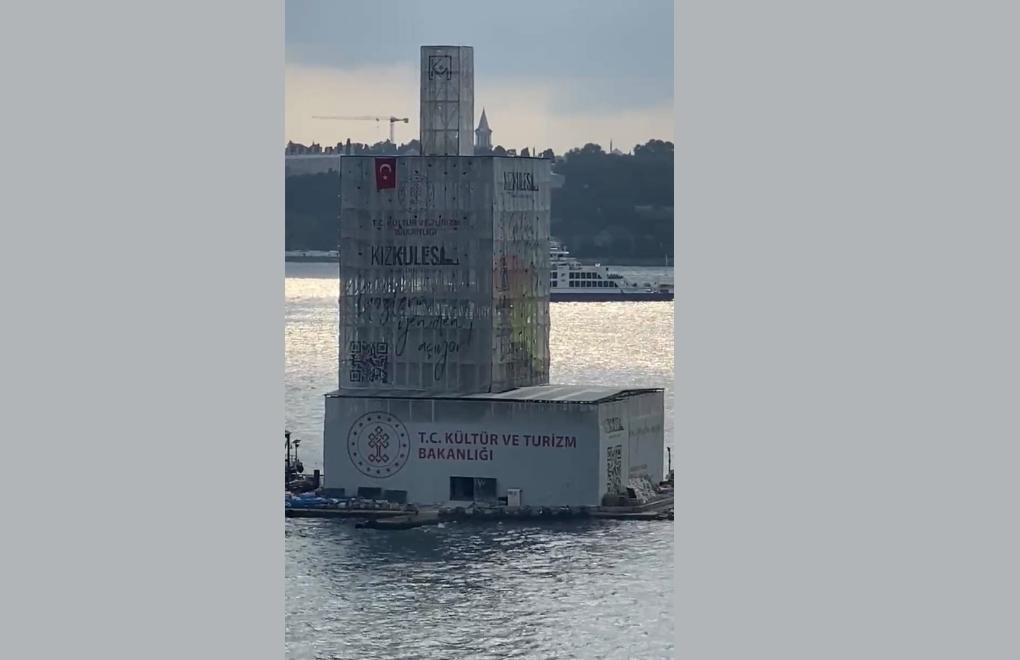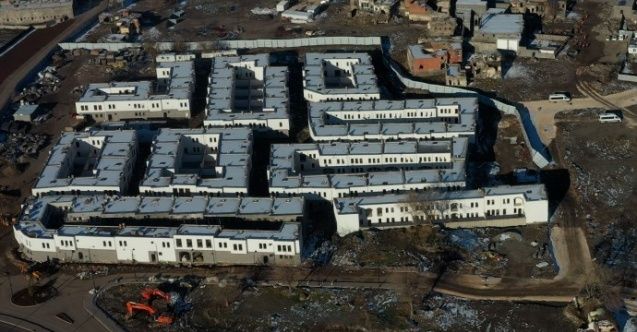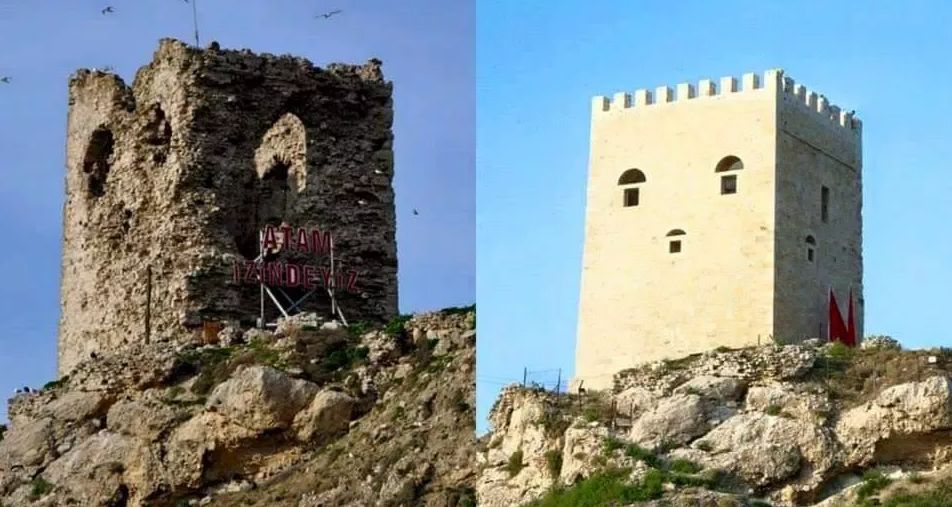Debate over restoration of Maiden's Tower: What is awaiting the iconic landmark of Bosphorus?

This photo of the "disappeared tower" circuated on social media last month, sarking debate. Later, it was revealed that the concrete parts were removed to be replaced with wooden ones
Last month, images appeared on social media, showing a destroyed Maiden's Tower (Kız Kulesi), an iconic tower on a small Islet in the Bosphorus. The General Directorate of Cultural Heritage and Museums swiftly responded, saying that the renovations had been going as planned since last year.
However, Türkiye's recent history with handling cultural heritage has not always been transparent and delicate.
Türkiye has been a signatory of the World Heritage Convention since 1983 and is nowadays home to 19 World Heritage Sites and has many more sites under consideration of becoming part of this prestigious list.
Besides the cultural value, heritage tourism is a lucrative business for the country, with areas such as Cappadocia filling the "Go Türkiye" advertisement spots and Göbeklitepe, the oldest building in the world, reaching a record number of visitors last year.
Yet, heritage preservation in Türkiye often goes hand in hand with destruction. Since the mid-2000s, widescale urban transformation has been going on under the guise of conserving historical and cultural sites.
A high-profile case was that of Sulukule, adjacent to the old historic Theodosian walls and historically home to many of İstanbul's Roma people. Lying within İstanbul's UNESCO world heritage site, the place was razed and newly built "luxury residences" displaced many of its original residents. Not long after that, the Bostans, İstanbul's historic urban gardens, also situated around the city's historic walls, were demolished. The idea was to build a city park, which has not been constructed to date.
"Fake history"
The historical inner city of Sur, Diyarbakır, is another example. Already designated as an urban development area in 2012, the site sustained heavy damages in 2015-2016 during an armed conflict between Kurdish militants and the army. During the conflict, then-PM Ahmet Davutoğlu advertised the inner city as becoming a new "Toledo."
 The new "prison-like" residences in Sur. (Photo: MA)
The new "prison-like" residences in Sur. (Photo: MA)
Fast-forward six years later, and much of the original historical architecture has been razed and replaced by almost identical-looking newly built housing, displacing many of its residents. Furthermore, "fake history" is being made. According to urban planner Dilan Kaya-Taşdelen, a community clinic in Sur was replaced with a new building and business named "Avni Bey Konağı," illegally built with stones of destroyed historical houses. The mansion claims that it is "350 years old."
However, the inhabitants wonder who Avni Bey is, as he is the father of the owner of another shop "Kemikli Evi". This impression of "Avni Bey Konağı" of being a historical structure is a manipulation of the urban memory, according to Taşdelen.
Botched restoration works
The handling of the restoration has raised some eyebrows over the years, not only for its social and spatial effects. Twitter accounts such as Çirkin İstanbul are full of tragic comical outcomes.
The 2000-year-old Ocaklı Castle, for example, became an internet hit for being 'spongebobified". Another restoration causing public outrage was that of İstanbul's other iconic tower, the Galata Tower, when videos online showed the use of hammer drills. A company with close ties to the government carried out the work.
 The Ocaklı Castle became an internet hit for being spongebobified during restoration.
The Ocaklı Castle became an internet hit for being spongebobified during restoration.
These restoration tragedies will likely continue as a recent change in regulations states that "mastery" would no longer be necessary for restoration works, according to the daily Cumhuriyet.
With these types of renovations happening across the country, scepsis towards the restoration of İstanbul's maiden tower is perhaps unavoidable. The tower's own renovation history has also not been without any controversy.
During restoration efforts in the 1940s and 1990s, the tower saw major physical changes. In 1944, major large parts of the tower were replaced with reinforced concrete and controversial restoration efforts between 1995-2000 added a restaurant. The current restoration intends to rebuild many parts of the tower with wood.
Architect Mücella Yapıcı, one of the convicts of the Gezi trial, recently wrote a letter from prison, pointing out some of the strange happenings occurring around the Maiden's tower. The architect revealed that the renovations to the iconic and symbolic building started with neither public debates nor discussions with professional institutions and organizations.
Moreover, Mücella Yapıcı claims that the renovations are conducted without an appointed architect, whereas Law 2863 states that the architect is held responsible for all the practices regarding cultural assets. Furthermore, the technical report, which is supposed to be prepared before the start of the project, was only approved 6 months after the implementation date.
The 1940 repair
Senior architect-restorer Seda Özen Bilgili, said in recent tweets that the upper and adjacent parts of the tower were dismantled because they were converted to reinforced concrete during the 1940 repair and will be rebuilt with wood.
She puts fate in the restorations as Prof. Dr. Zeynep Ahunbay and Han Tümertekin are the advisors of the project. Stating that unlike, the architect of the 1995 restoration of the Maiden's Tower who was banned from the profession for years, these architects don't have such a track record.
However, she is also is of the opinion of that there should be more transparency, demanding that the restoration canvas of the Maiden's Tower should be opened immediately to show the tower.
Despite all the controversy around the monument, The General Directorate of Cultural Heritage and Museums reassured everyone that the Maiden's tower is in good hands and that in 2023, on the 100th anniversary of the Republic, the tower can be admired once again with all its monumental and historical value. (WM/VK)
İstanbul Pride Parade: LGBTI+ activists gather despite restrictions, nearly 100 detained
.jpg)
Hearing of dozens in Boğaziçi Pride trial marks Turkey's Pride Month start
.jpg)
Seventy students on trial for Boğaziçi pride participation amid torture allegations
.jpg)
Countdown to Turkey's presidential runoff: Propaganda ban begins ahead of Sunday's vote
.jpg)
Turkey’s parliamentary election outcomes: more women, conservatives, and nationalists
.jpg)





.jpg)
.jpg)